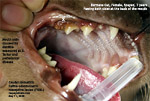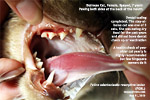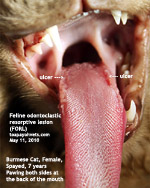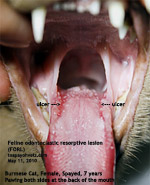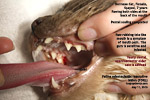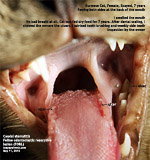Ms Teresa Formicelli , my veterinary intern placed the Burmese cat on the electronic weighing platform, looked at the digital reading in the green-window placed on a side table beside the platform and said in her usual soft barely audible voice: "2.6 kg". A new client had brought in the cat for consultation as she had been pawing her mouth recently. The owner of the cat was a Caucasian couple. I seemed to have seen the wife before but could not pinpoint when. The husband told me that I had treated his wife's horse. It was a horse that nearly kicked me.
"Are you sure the cat weighs 2.6 kg? Are you sure" I carried the 7-year-old spayed female Burmese cat with both hands. This cat had a solid compact light brown body because it was well fed and cared for. From my experience, this older cat should be heavier than 2.6 kg.
Mrs Thiele, a tall slim sun-tanned lady looked at Teresa and said: "The cat is heavier than that."
"Weigh the cat again," I instructed Teresa. This was a quiet cat and she had sat quietly on the weighing platform unlike other cats running away. Therefore, I was much surprised that Teresa could make a mistake. I said: "The cat may be 3.6 kg in weight."
Teresa who would be studying veterinary medicine in Oct 2010 took the cat from me and put the cat on the weighing platform. "3.6 kg," Teresa said. Mr and Mrs Thiele did not comment and I hope they would be forgiving. It was an embarrassment for me and I had no explanation but should have offered an apology.
This was a serious mistake which I did not expect Teresa to make at all. This 18-year-old girl had As in her Advanced-level examinations, except for a Grade B in the Chinese language. She was accepted by a Vet School in the United Kingdom and was doing internship. The University wanted proof that she had worked 2 weeks in a veterinary practice. She was about to complete two months and was closely supervised. Except for weighing of this Burmese cat.
Having interns who make mistakes can be damaging to client's perception of the practice. Mr and Mrs Thiele were first-time consulting me. New clients just go elsewhere the next time or bad mouth the practice when serious mistakes are made. This is one reason why one big veterinary practice in Singapore does not bother with interns. Nowadays I qualify interns strictly before I accept them. They need to excel in their studies and be accepted to study veterinary medicine. Yet this incident happened. Why? The Divine Powers must be playing tricks on me if you believe in higher powers.
I asked Teresa for an explanation 2 days later. She said: "I saw 3.6 kg but I said 2.6 kg." This answer was mysterious to me. Was she a forgetful girl? How could a forgetful girl score top marks in the intensive A-level examinations? It does not make sense.
As for the Burmese cat, Mr Thiele was very happy when I phoned him the next day. He said that the cat was no more pawing and was eating. At the consultation, Mr Thiele had observed that the cat was pawing her right side of the mouth but Mrs Thiele said: "The cat put her paws in the left side of the mouth as well."
This was a case of FORL (feline odontoclastic resorptive lesion). This disease occurs in 2/3 of the domestic cats according to one report. Basically it is a periodontal disease with infections and reactions over time wearing away the protective enamel of the teeth. The mouth became painful.
Therefore, the vet must not just give some antibiotics. Dental work is necessary. I injected a mixture of 0.1 ml xylazine 2% and 0.4 ml ketamine in a syringe IM to sedate the cat for dental scaling. Tartar had formed and the bacteria infections had eroded the gum margins of the side teeth on the lower and upper jaws. Parts of the enamel of the side teeth would have been eroded exposing the dentine. The sensitive dentine became painful and so the cat had to paw her mouth many times to counter the mouth pain.
P.S
The cat
had two long ulcers at the back of the tongue
(see pictures) as well as periodontal disease in
the side teeth (premolars and molars). Since the
cat uses the side teeth for cutting instead of
grinding food as in most mammals, it is possible
that the cat's side teeth cut into the back half
of the tongue, causing two red linear ulcers at
the back of the tongue as the cat paws its mouth
many times.
UPDATE 7 DAYS LATER. No complaint from the
owners. I presume all are well with the cat. I
continue to take in interns but will have to be
much stricter.
 TOA
PAYOH VETS
TOA
PAYOH VETS
